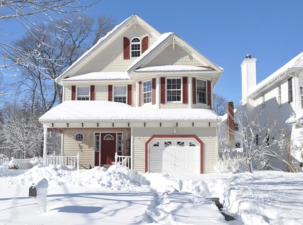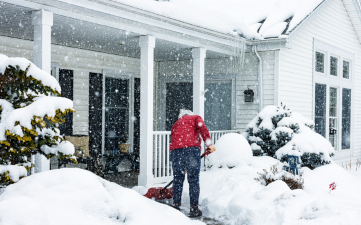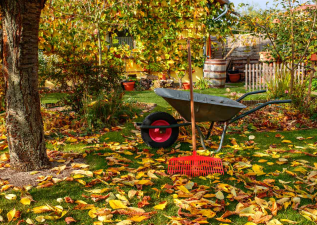How to Prep Your Home for Harsh Winter Weather
Enjoying a peaceful winter is crucial for avoiding the unpleasantness of freezing temperatures. Therefore, it's best to inspect your home's interior and exterior in advance to identify any potential problems.
Besides saving you a lot of worry later, these inspections can also help you save significant energy and, more importantly, optimize your comfort.

- About Windows and Doors
Air and water infiltration are most common in winter, especially in older homes. Carefully inspect the edges of your windows and doors to determine if they're prone to this problem. Also, ensure that your windows and doors fit perfectly in every room of the house. Otherwise, your home will undoubtedly experience significant heat loss, which will directly impact your heating comfort and energy bills.
32% of heat loss in a home is caused by inadequate insulation or poorly sealed windows and doors. Caulking your windows and doors is the best way to protect your home from infiltration. If you notice your caulk is particularly dry or discolored, it's definitely time to replace it. Whether you're looking to do it yourself or hire a professional, this task should be prioritized.
- Weatherstripping and Door and Window Accessories
Before winter even arrives, you'll find hardware store shelves stocked with dozens of products to protect your windows and doors from infiltration. Weatherstripping keeps warm air inside and prevents cold air from entering your home. This ensures your comfort while automatically reducing your home's energy consumption.
-Window film: This film comes in the form of clear plastic that you roll along the window. The film comes with double-sided tape, which you apply to the window frame. A hair dryer is then used to ensure the plastic adheres properly to the glass.
-Door bottoms: It's common to find that fresh air can enter through the bottoms of doors. To address this issue, it's recommended to install weatherstripping under each door, especially front doors. There are several different types of door bottoms: adhesive or non-adhesive, screw-on, cast, and swivel. The choice depends on your needs and the type of door you have.
-Foam, rubber, or silicone tape: These materials can help seal various openings and prevent drafts, water, dirt, and even insects.

- Remove Window Screens
Whether your window screens are installed on the inside or outside of your windows, it's recommended to remove them in the winter. Since there are fewer insects in winter and you open your windows much less often than in the summer, why keep them?
Removing window screens allows light to easily enter the house, while sunlight from outside easily warms the room. This extends their lifespan and prevents them from breaking in inclement weather. Before putting away your window screens, thoroughly clean them with soapy water and a damp cloth, let them dry, and then store them in a safe place.
- Prepare for winter from the inside
Prepare your home from the inside by cleaning the baseboards, especially to prevent odors and dust from circulating during heating. Believe it or not, air can also enter through vents.
To address this issue, you can easily find these accessories at hardware stores: small foam pads designed specifically for this purpose. These can be placed inside each vent to reduce cold air infiltration. You can also use safety caps on outlets that are rarely or never used.
Do you have a room equipped with a portable air conditioner? It's best to remove it from the window and seal it properly. If you decide to leave it in place, be sure to cover it with a canvas sheet and ensure a good seal around the perimeter. Additionally, if you notice your house becoming damp with the arrival of cold weather, it's recommended to purchase a dehumidifier.
A dehumidifier can reduce humidity levels and address condensation on windows and walls. Dampness can be caused by both indoor and outdoor factors. This problem can easily lead to health problems and mold growth in the home.
- Preparing the Exterior of the House
In winter, especially when temperatures are very low, avoid opening windows and doors for ventilation. During this time, it's crucial to ensure proper ventilation, especially for clothes dryers and range hoods. The APCHQ also recommends cleaning air exchanger filters, which inevitably accumulate dirt during periods of inactivity. Another area to check is the air exchanger drain hose, which must be properly connected and must not be dragged on the floor to prevent water from escaping the condensation drain circuit.
Furthermore, small animals often seek refuge in private homes over the winter. The cold draws them to warmer areas. Before the weather gets colder, inspect your house's exterior walls, joints, and foundation. Check the foundation and perimeter, as well as air inlets and outlets. If there are small cracks in the foundation, contact a professional foundation contractor.
Gather leaves and branches from around your house or on your apartment balcony. This will prevent ants or rodents from building nests. Ants can live deep underground during cold weather. If you see ants in your home during the winter, you likely have a nest.

- Prepare your roof and chimney
Before the cold weather arrives and the first snow falls, inspect the roof's basic condition yourself or have a professional do it, depending on your home's condition. It's also important to contact a chimney sweep to clean the chimney. This not only reduces the risk of fire but also ensures the heating system operates safely. Also, check the chimney's caulking to ensure it's properly sealed and free of water leaks.
In addition, cleaning roof gutters by removing leaves and branches from previous seasons can help prevent overflows and ice buildup on the roof. Be sure to remove any pipes connected to your gutters, as leaving them in place will prevent water from draining away during the spring thaw.
- Land and Carport
Now is the time to close off your backyard by putting away your outdoor furniture and barbecue grill. Remember to empty your garden hose and store it away. Close the valves on your outdoor pipes to prevent the water from freezing. Protect shrubs with protectors and cut back branches that could cause problems during the winter. As for your carport, make sure it's secure.
Maintain your lawn before winter. You can continue mowing until October or November. Continuously watering the lawn will help it establish roots during the winter. Fertilizing your lawn in September or October will allow your lawn to begin storing fertilizer for the spring.


